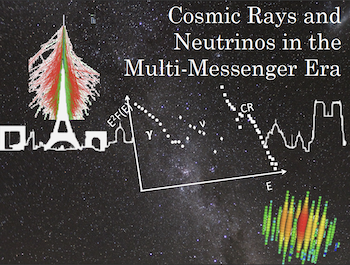A small fraction of GRBs with available data down to soft X-rays ( ~0.5 keV) have been shown to feature a spectral break in the low energy part of their prompt emission spectrum. The overall spectral shape is consistent with optically thin synchrotron emission from a population of marginally fast cooling particles. If the radiating particles are electrons, this interpretation implies...
ANTARES and Baikal-GVD are both Cherenkov neutrino telescopes located in
the Northern Hemisphere. As a consequence, their fields of view overlap allowing
for a combined study of the sky. Since December of 2018, Baikal followed up
a total of 25 ANTARES alerts, and while no prompt coincidence was found, a
cascade mode search showed some events falling within an angular distance of
less than...
Baikal Gigaton Volume Detector (Baikal-GVD) is a 1 km$^3$ neutrino detector currently under construction in lake Baikal, Russia. The detector consists of several thousand optical sensors arranged on vertical strings. The strings are grouped into clusters of 8 strings each. Each cluster can operate as a stand-alone neutrino detector, providing an effective volume of $\sim$ 0.05 km$^3$. A fast...
High energy neutrino alerts observed by IceCube in Fall 2020, have been
performed in fast regime using Baikal-GVD data first time. Search for
correlations between alerts and events reconstructed in two modes, track
and cascade, for the time windows \pm 1 hour and \pm 12 hours
does not indicate statistically significant excess of the number over
the expected number of background events....
Production of Z bosons in emission processes by neutrinos in the expanding de Sitter universe is studied. We use perturbative methods to investigate emission processes that are forbidden in flat space-time electro-weak theory by the energy and momentum conservation. The amplitude and probability for the spontaneous emission of a Z boson by a neutrino or an antineutrino are computed...
Experiments like the Pierre Auger observatory, the Telescope Array and soon the space telescope JEM-EUSO are investigating ultra-high-energy cosmic rays (UHECRs) in order to determine their identity and their mysterious origin. These experiments are mainly based on indirect and simultaneous measurements of parameters such as the primary energy $E_0$ and the slant depth of the shower maximum...
The next Galactic supernova will be a once-in-a-lifetime opportunity for multi-messenger astronomy. A core collapse will produce a neutrino burst visible hours to days before electromagnetic radiation from the explosion, so the burst will provide an early warning for optical follow-up and offer valuable insight about the proto-neutron star. Since local supernovae are exceedingly rare, it is...
After more than 100 years since their discovery, cosmic rays (CRs) are still one of the most intriguing open questions in astrophysics. Different astrophysical objects, such as black holes in active galaxies, gamma-ray bursts, supernova shocks, etc., have been proposed as sources of high-energy CRs, but any scientific attempt to track back the sites of their production and acceleration is...
The composition in terms of nuclear species of the primary cosmic ray flux is largely uncertain in the knee region and above. The possibility of testing it in the measured flux of atmospheric leptons in very large volume Cherenkov detector such as IceCube and ANTARES has been tested in this contribution. Two possible models of cosmic ray composition have been used to produce pseudo-data sets...
Uncovering the sources of the astrophysical neutrinos observed by IceCube has been one of the most daunting challenges of neutrino astronomy since their discovery in 2013. By taking advantage of the multimessenger nature of these sources, it is possible to extract important information from them. In particular, we expect their production of TeV-PeV neutrinos to be accompanied by a $\gamma$-ray...
The Radar Echo Telescope for Neutrinos (RET-N) project aims to detect astrophysical neutrinos with energies of 10 PeV (10$^{16}$ eV) and above using the radar echo technique. The results of SLAC experiment T-576 show that a high-energy neutrino interacting in a dense medium like ice will create a short-lived plasma with the ability to reflect incoming radio waves. By detecting the reflection...

